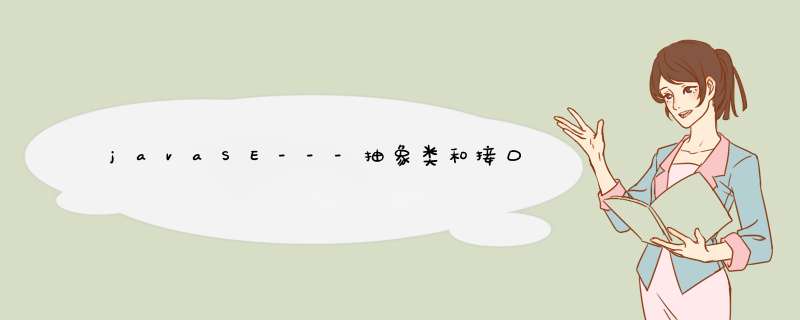
目录
抽象类
接口
接口
接口的实现类
三个常用接口
comparable
comparator
cloneable接口
深浅拷贝
抽象类
抽象方法:一个没有具体实现的方法,被abstract关键字修饰
关键类:包含抽象方法的类
abstract class Draw{
public abstract void draw() ;
}
抽象方法不能有主体
抽象方法不能实例化
抽象类中可以包括普通成员
abstract class Draw{
int age;
String name;
public void print() {
System.out.println("hi");
}
public abstract void draw() ;
}
抽象类只能被继承,子类必须重写父类里的所有抽象方法(子类如果是抽象类,可以只实现一部分)
abstract class Draw {
public abstract void draw();
}
class Fun extends Draw{
@Override
public void draw() {
System.out.println("hehe");
}
}
public class text {
public static void main(String[] args) {
Fun fun=new Fun();
fun.draw();
}
}
Fun类继承了这个抽象类,并且对这个抽象类的抽象方法进行了重写,实例化子类调用子类中重写的方法
抽象类也可以发生向上转型和动态绑定
abstract class Draw {
public abstract void draw();
}
class Flower extends Draw{
@Override
public void draw(){
System.out.println("❀");
}
}
class Square extends Draw{
@Override
public void draw(){
System.out.println("■");
}
}
class Triangle extends Draw{
@Override
public void draw(){
System.out.println("");
}
}
public class text {
public static void Draw(Draw Draw) {
Draw.draw();
}
public static void main(String[] args) {
Draw(new Flower());
Draw(new Square());
Draw(new Triangle());
}
}
抽象类不能被final修饰
final类是最终类,被final修饰的类不能被继承,而抽象类的作用就是被继承
接口 接口如果一个类中全部的方法都是抽象的,那么可以将这个类定义为接口
接口是一种特殊的抽象类,它不能包含普通方法,其内部的所有方法都是抽象的
JDK8中,对接口进行了重新定义,接口中除了抽象方法外,还可以有默认方法和静态方法,默认方法使用default修饰,静态方法用static修饰,并且这两个方法都允许有方法体
定义接口,要用interface关键字
interface AI{
public abstract void fun();
}
interface AI{
public abstract void fun();
default public void print(){//默认方法
System.out.println("hi");
}
public static void sub(){//静态方法
}
}
接口里的所有方法都是public的接口不可以使用new来创建对象接口内部有3种方法,抽象方法,静态方法,默认方法借口内部的成员变量默认类型:public static final,一定要初始化
静态方法可以通过接口名.静态方法名来调用
interface AI{
public abstract void fun();
default public void print(){
System.out.println("hi");
}
public static void sub(){
System.out.println("ok");
}
}
public class text {
public static void main(String[] args) {
AI.sub();
}
}
默认方法和抽象方法要通过类的实例化调用
接口的实现类接口的实现类通过implements关键字实现当前接口,并重写接口的所有抽象方法
interface AI{
public abstract void fun();
default public void print(){
System.out.println("hi");
}
public static void sub(){
System.out.println("ok");
}
}
class A implements AI{
@Override
public void fun() {
System.out.println("❀");
}
}
public class text {
public static void main(String[] args) {
A a=new A();
a.fun();
}
}
A类实现了AI口,并对AI接口的抽象方法进行了重写,通过对A类的实例化对象可以引用AI接口的成员(除了静态方法)
1.一个类可以实现多个接口
interface AI{
public abstract void funA();
}
interface BI{
public abstract void funB();
}
class A implements AI,BI{
@Override
public void funA() {
System.out.println("❀AI");
}
@Override
public void funB() {
System.out.println("❀BI");
}
}
A类继承了AI,BI接口,要对AI,BI的所有抽象方法进行重写
2.一个类可以继承一个类同时实现多个接口
interface AI{
public abstract void funA();
}
interface BI{
public abstract void funB();
}
abstract class B{
abstract void fun();
}
class A extends B implements AI,BI{
@Override
public void funA() {
System.out.println("❀AI");
}
@Override
public void funB() {
System.out.println("❀BI");
}
@Override
void fun() {
System.out.println("hi");
}
}
A类继承了抽象类B,并继承了AI,BI接口,要对B,AI,BI的所有抽象方法进行重写
3.接口可以扩展一个接口(extends)
interface AI{
public abstract void funA();
}
interface BI extends AI{
public abstract void funB();
}
class C implements BI{
@Override
public void funB() {
}
@Override
public void funA() {
}
}
BI接口扩展了AI接口,那么BI接口就会包含了AI接口的成员,C类继承了BI接口,要对BI接口的所有抽象方法重写
三个常用接口 comparablepublic class text {
public static void main(String[] args) {
int[] arr = {1, 2, 3, 1};
System.out.println(Arrays.toString(arr));
Arrays.sort(arr);
System.out.println(Arrays.toString(arr));
}
}
sort方法实现了数组排序
class Student {
int age;
String name;
public Student(int age,String name) {
this.age = age;
this.name = name;
}
@Override
public String toString() {
return "Student{" +
"age=" + age +
", name='" + name + ''' +
'}';
}
}
public class text {
public static void main(String[] args) {
Student []student=new Student[3];
student [0]=new Student(10,"张三");
student [1]=new Student(9,"李四");
student [2]=new Student(3,"王五");
System.out.println(Arrays.toString(student));
Arrays.sort(student);
System.out.println(Arrays.toString(student));
}
报错原因:不知道按照什么条件来排序
sort方法的源码:发现数组元素被强制转化为comparable
如何解决:
使用Comparable接口:让类实现这个接口
进入Comparable接口
那么正确的实现方法:
实现这个接口并对public int compareTo(T o)方法重写
@Override
public int compareTo(Student o) {
if (this.age > o.age) {
return 1;
} else if (this.age == o.age)
return 0;
else
return -1;
}
// return this.age-o.age;可以简化
}
根据年龄比较:
根据姓名比较:如果使用equals方法, 字符串比较返回值boolean类型,不能强制转化为int
打开String 的源码:
发现String也调用了这个接口,那么也一定有compareTo(T o)方法,Alt+7找到这个方法:
调用这个方法就可以来比较了
class Student implements Comparable{ int age; String name; public Student(int age, String name) { this.age = age; this.name = name; } @Override public int compareTo(Student o) { return this.name.compareTo(o.name); } @Override public String toString() { return "Student{" + "age=" + age + ", name='" + name + ''' + '}'; } } public class text { public static void main(String[] args) { Student[] student = new Student[3]; student[0] = new Student(10, "张三"); student[1] = new Student(3, "王五"); student[2] = new Student(9, "李四"); System.out.println(Arrays.toString(student)); Arrays.sort(student); System.out.println(Arrays.toString(student)); }
但是我们发现,用这个接口,要重写 compareTo()方法,但是这个方法只能有一个,只能按照一种办法来比较,使用comparator接口可以实现多种比较
comparatorsort有许多种参数不同的实现方法,可以看到其中有一个方法参数是comparator
打开comparator这个接口
使用comparator接口可以实现多种比较
class Student {
int age;
String name;
public Student(int age, String name) {
this.age = age;
this.name = name;
}
@Override
public String toString() {
return "Student{" +
"age=" + age +
", name='" + name + ''' +
'}';
}
}
class AgeComparator implements Comparator{//类实现了接口
@Override
public int compare(Student o1, Student o2) {
return o1.age-o2.age;
}
}
class NameComparator implements Comparator{//类实现了接口
@Override
public int compare(Student o1, Student o2) {
return o1.name.compareTo(o2.name);
}
}
public class text {
public static void main(String[] args) {
Student[] student = new Student[3];
student[0] = new Student(10, "张三");
student[1] = new Student(3, "王五");
student[2] = new Student(9, "李四");
System.out.println(Arrays.toString(student));
AgeComparator ageComparator = new AgeComparator();//实例化类 按照年龄比较
Arrays.sort(student, ageComparator);//传入参数有两个
System.out.println(Arrays.toString(student));
Arrays.sort(student, new NameComparator());
System.out.println(Arrays.toString(student));
}
cloneable接口
object类有一个clone方法,使用这个方法可以进行拷贝,但是要调用这个方法,要先实现cloneable接口,否则会报错
打开clone方法
发现clone()的返回值类型是object,所以进行强制类型转化
但是仍然有错误,必须实现cloneable接口
打开cloneable接口
cloneable接口内没有方法体,不需要对接口的内部方法进行重写
没有方法体的接口称之为标志接口,标志接口代表当前这个类是可以被克隆的
但是规定:要求在类中重写clone方法
class Person implements Cloneable{
int age;
@Override
protected Object clone() throws CloneNotSupportedException {
return super.clone();
}
}
但是这时候发现,仍然有问题:
点击以下内容,对异常进行声明:
class Person implements Cloneable{
int age;
@Override
protected Object clone() throws CloneNotSupportedException {
return super.clone();
}
}
public class text {
public static void main(String[] args) throws CloneNotSupportedException {
Person person = new Person();
Person p=(Person) person.clone();
}
}
深浅拷贝
代码1:
class Person implements Cloneable{
int age=9;
@Override
protected Object clone() throws CloneNotSupportedException {
return super.clone();
}
}
public class text {
public static void main(String[] args) throws CloneNotSupportedException {
Person person = new Person();
System.out.println(person);
Person p=(Person) person.clone();
System.out.println(p);
p.age=109;
System.out.println(person.age);
System.out.println(p.age);
System.out.println(person.age);
}
}
对person引用的对象的成员信息拷贝之后产生一个副本,p引用了这个新的对象,所以person和p的地址不相同 ,对p的成员改变不会影响person的成员
代码2:
class A{
int s=78;
}
class Person implements Cloneable{
int age=9;
A a=new A();
@Override
protected Object clone() throws CloneNotSupportedException {
return super.clone();
}
}
public class text {
public static void main(String[] args) throws CloneNotSupportedException {
Person person = new Person();
Person p=(Person) person.clone();
System.out.println(p.a);
System.out.println(person.a);
}
对person引用的对象的成员信息拷贝之后产生一个副本,p引用了这个新的对象,所以person和p的地址不相同
但是因为person引用的对象中,有一个引用成员变量a,现在的代码导致产生的副本和person引用的成员中的变量a,引用了同一个对象
这是一个浅拷贝
代码3:
class A implements Cloneable{
int s=78;
@Override
protected Object clone() throws CloneNotSupportedException {
return super.clone();
}
}
class Person implements Cloneable{
int age=9;
A a=new A();
@Override
protected Object clone() throws CloneNotSupportedException {
Person p = (Person) super.clone();//先对person克隆
p.a = (A) a.clone();//对person中a的克隆
return p;
}
}
public class text {
public static void main(String[] args) throws CloneNotSupportedException {
Person person = new Person();
Person p=(Person) person.clone();
System.out.println(p);
System.out.println(person);
System.out.println(p.a);
System.out.println(person.a);
System.out.println(p.a.s);
System.out.println(person.a.s);
p.a.s=90;
System.out.println(p.a.s);
System.out.println(person.a.s);
}
}
对person和a两个引用变量都进行了拷贝
这是一个深拷贝
欢迎分享,转载请注明来源:内存溢出

 微信扫一扫
微信扫一扫
 支付宝扫一扫
支付宝扫一扫
评论列表(0条)